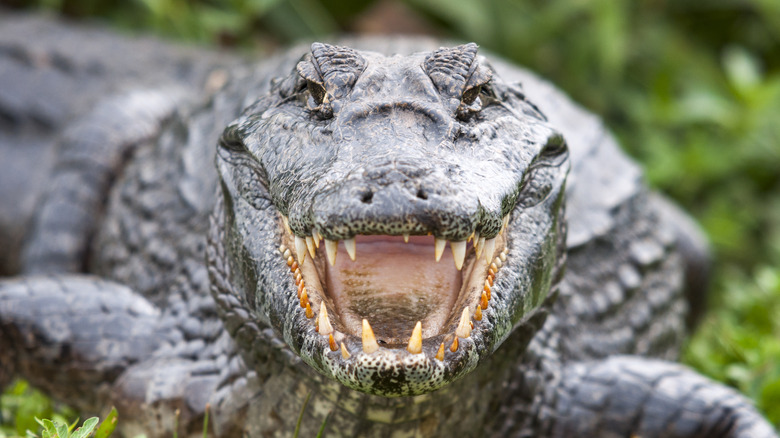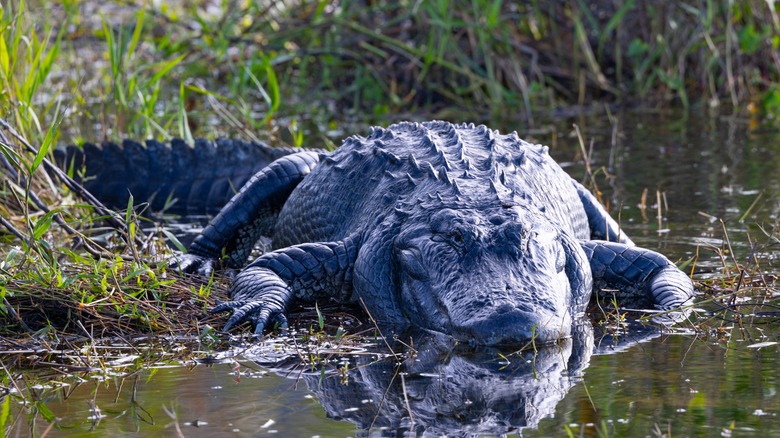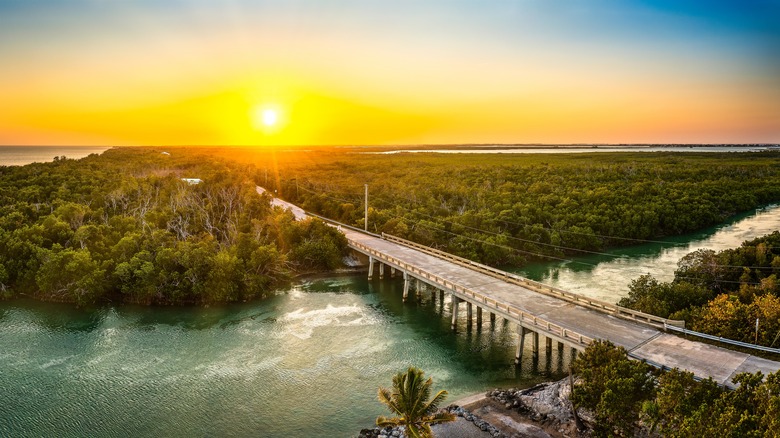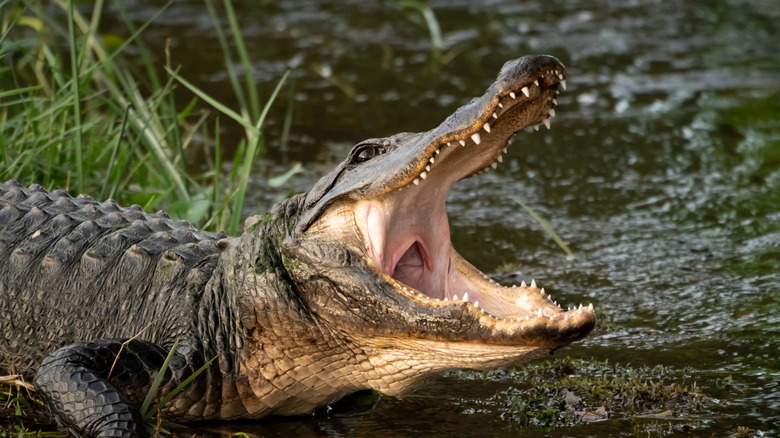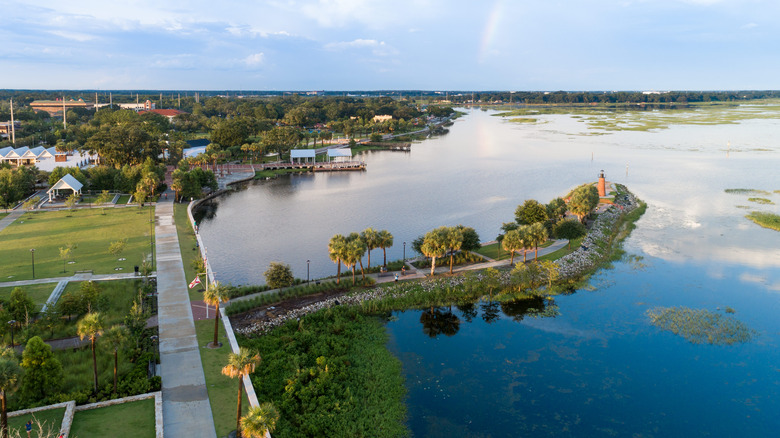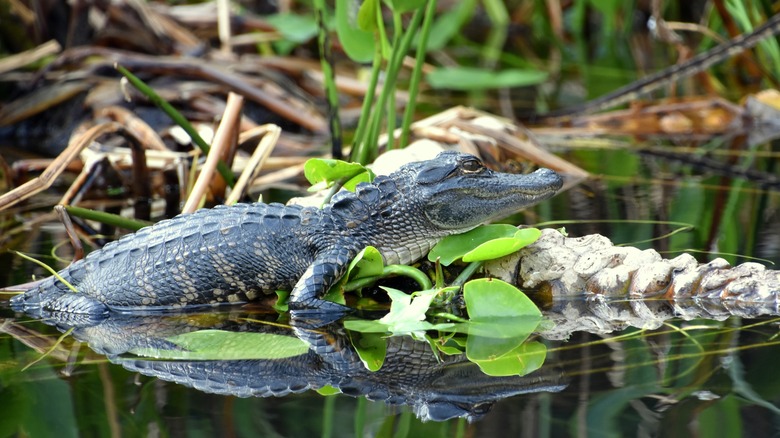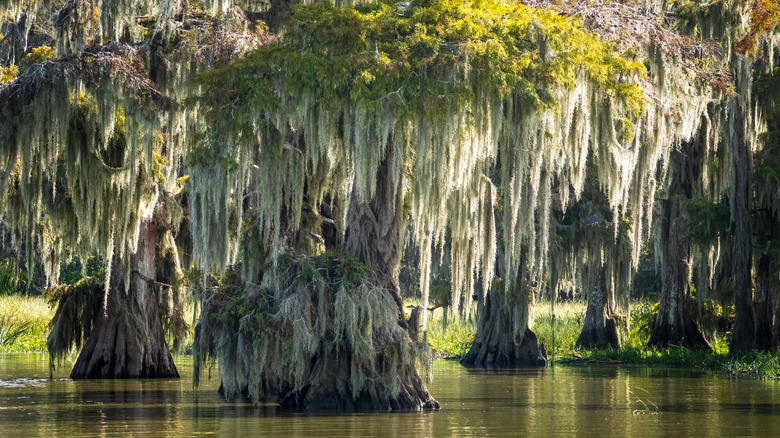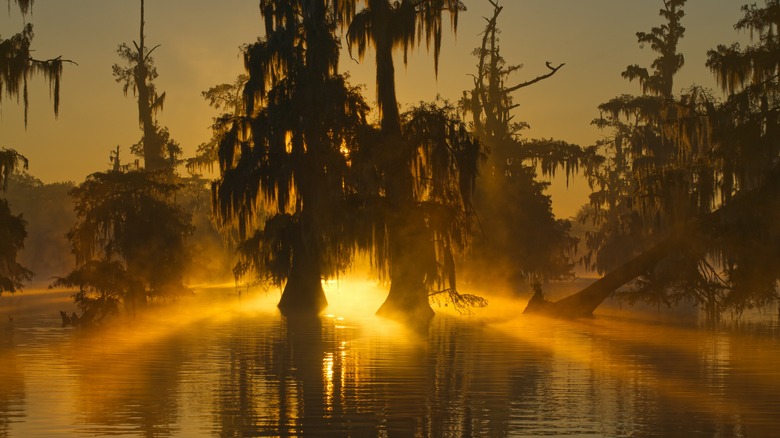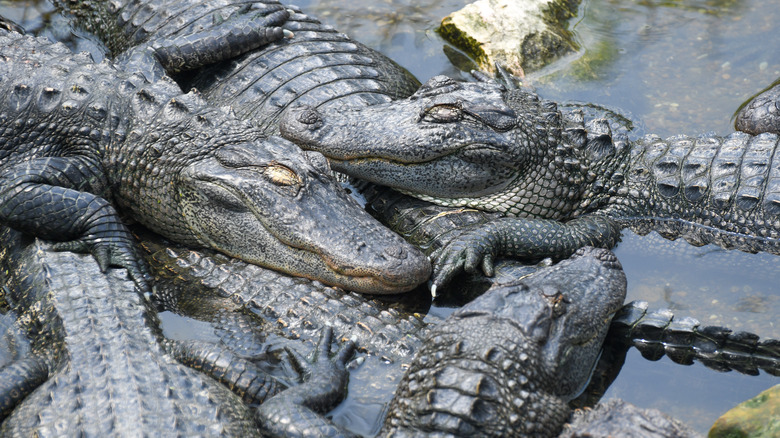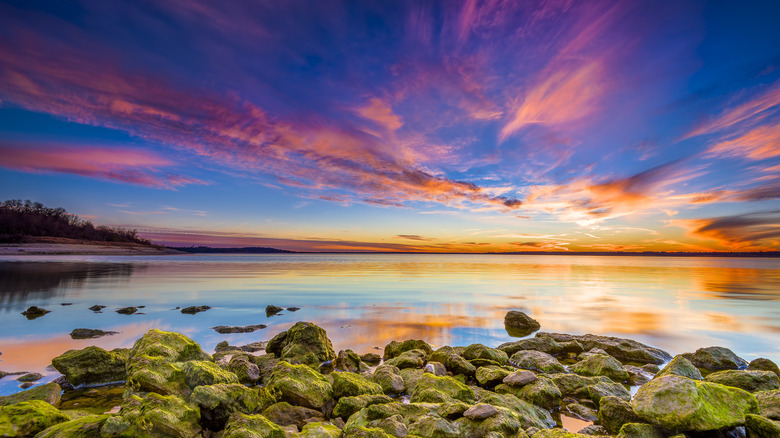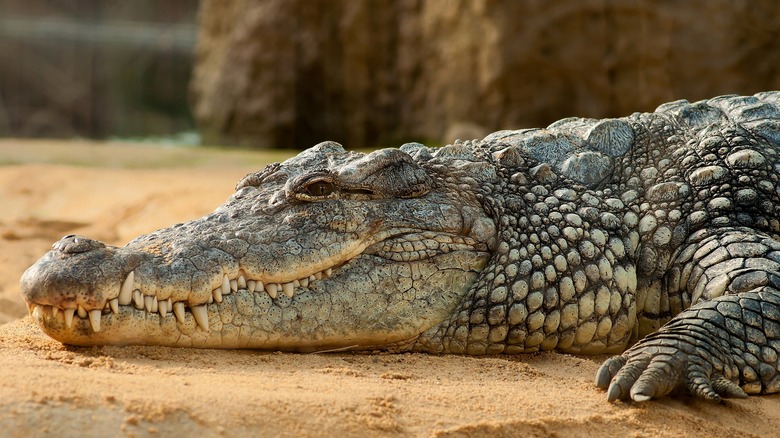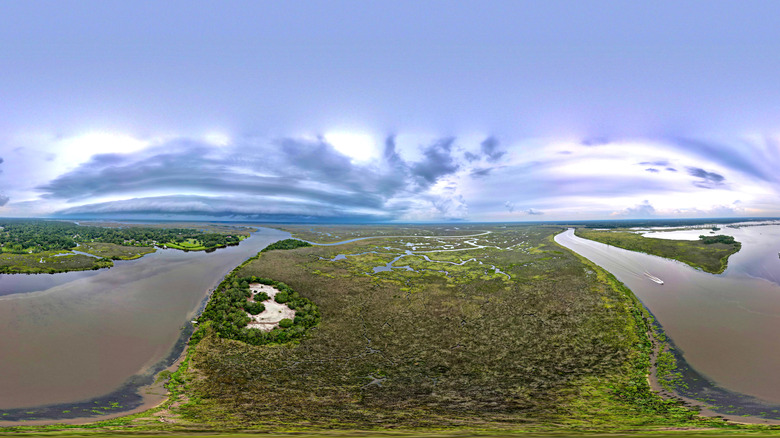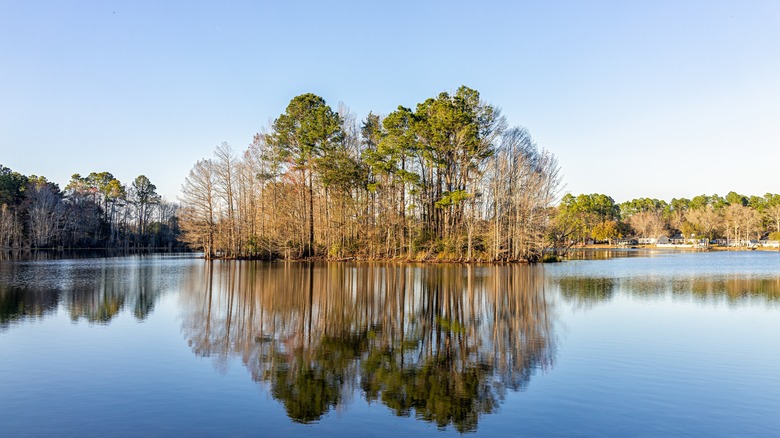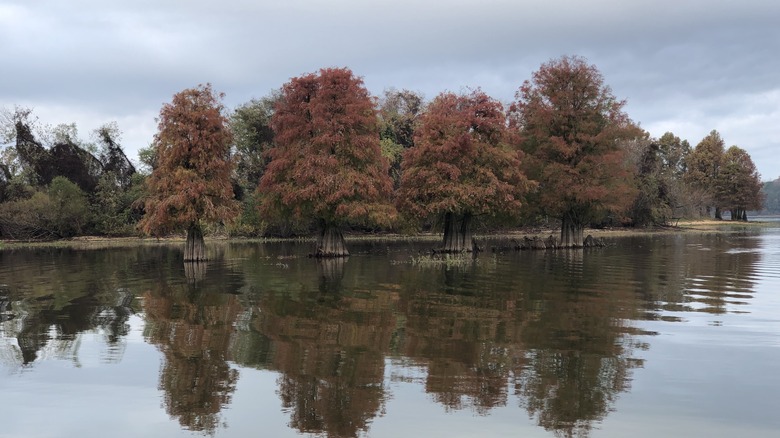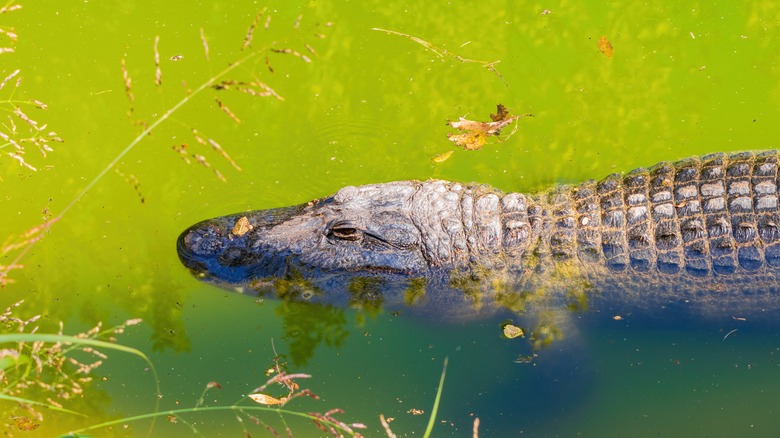Dangerous Crocodile And Gator-Infested Waters In The US To Avoid
If you think of a large creature lurking underwater, silently making its way toward you as it opens its jaws to take a bite, you will likely hear a very iconic movie theme playing in your head. Likewise, the creature in your imagination is probably a gigantic shark with an enormous set of teeth. However, there is another set of weather-dwelling leviathans that are, according to Business Insider, 100 times as deadly as sharks. We're talking, of course, about crocodiles and alligators.
If any creatures deserve their own scary theme music, it is crocodiles and alligators. Perhaps the closest thing we'll ever see to actual living dinosaurs, crocodiles and alligators proliferate both fresh and saltwater bodies the world over. Sure, we may know crocodiles as being most iconically from Africa and Australia, but the United States has its fair share of the cold-blooded beasts, too.
In point of fact, some of the most crocodile and alligator infested waters are right here in the good ol' U.S. of A. They are definitely places you'll want to avoid swimming in because these strong-jawed terrors have absolutely no qualms about taking on humans. And yes, a good portion of this list is going to be dedicated to one state in particular. We'll leave you to guess which one.
The Everglades, Florida
To the surprise of no one, the first third of this list is going to consist of waters found within the borders of the state of Florida. Home to some 1.3 million alligators and thousands of crocodiles, Florida is the place to be if you want to catch a glimpse of these amazing reptiles. The state has exactly the kind of warm, water-filled habitats that both creatures love. And it wouldn't be a list of crocodile and alligator-infested waters if we didn't talk about the Everglades.
Among the most iconic of Florida's natural landmarks, the Everglades are defined by their sharp grasses, diverse ecology, and their utter uniqueness among landscapes. They also happen to be home to nearly all of Florida's crocodiles. The Everglades and other areas of southern Florida are home to the only crocodiles found in North America and are the only place in the world where alligators and crocodiles coexist together. The Everglades also see their fair share of invasive species. According to The Guardian, Nile crocodiles, a species far deadlier than American crocodiles, were found between 2009 and 2014.
So, in the Everglades, these iconic reptiles are never too far away. The area is home to over 200,000 alligators and 3,000 crocodiles . They are the main reasons why you should always be with a professional guide when exploring the Everglades. It is a beautiful but dangerous place to visit.
The Florida Keys
Though not as wild as the Everglades — at least depending on how late you're out in Key West — Florida's Keys are nevertheless home to their fair share of crocodiles and alligators. Though their numbers tend to be on the smaller side when compared to the other places on this list, it's worth mentioning because there have been instances of massive crocs and gators blocking highways, and even ending up in people's swimming pools.
An archipelago of islands connected by several amazing bridges, The Keys provide a perfect sanctuary for crocodiles and alligators. Not only are the water temperatures perfect, but the mangrove forests, swampy inlets, and extension of marine life from the Everglades provide ample opportunities for food and shelter.
The population of alligators and crocodiles in this area ranges on the low side, owing to American crocs and alligators preferring freshwater as opposed to saltwater. Though, as the Miami Herald noted, the presence of saltwater crocodiles has increased recently. However, the regularity with which each is seen could lead one to believe that there are more of them than actually exist. While The Keys are still more than safe enough to swim off of, you definitely want to stick to the regular beaches instead of swimming near more forested areas.
Lake Jesup, Florida
Moving up the peninsula to central Florida, we have Lake Jesup. One of the largest lakes in the area, Jesup covers an expanse of roughly 16,000 acres and provides exactly the kind of prey fodder and environment that alligators absolutely adore. Note that from here on, this is going to be an alligator-centered list. As mentioned, American crocodiles have not been found anywhere in the United States except in southern Florida — at least not naturally.
Still, though they are smaller in size than crocodiles, alligators still cause some significant damage if they feel so inclined. Lake Jesup, thanks to its size, abundance of fish, and several swampy areas, creates the perfect environment for alligators to thrive in. Perhaps that's why there is a population of over 13,000 living in the waters and tributaries of Lake Jesup, according to Fox 35.
Now, before you declare that you're never going to this lake, take into account the fact that, despite the enormous population of alligators, there have been no fatal attacks on people or animals. Still, it's not a place you should be swimming or fishing. The alligator isn't Florida's symbol for nothing.
Lake Kissimmee, Florida
You don't want to be anywhere near an alligator's mouth at Lake Kissimmee. That's because there are over 2,000 of them prowling the waters of this most comically-named of Florida's lakes (via Channel 8 WFLA).
Interestingly enough, the best time to see an alligator in Florida is during winter. The water temperature cools and stays cold at a more consistent rate than the air temperature does. Because alligators are cold-blooded, they require sunlight in order to regulate their internal body temperatures. So, if you're visiting Lake Kissimmee in the wintertime, you're going to come across more gators because they are surfacing in order to get warm.
Now, in Florida, it is illegal to kill or trap a gator unless you are defending yourself. Never, under any circumstances, should you ever attempt to aggravate one. You are more likely to get seriously injured than the alligator will, and, to top it all off, you'll be considered a third-degree felon, per Click Orlando.
Alligator Lake, Florida
Yep. That's its real name. Alligator Lake is an actual place. Here's the irony of the situation, though. Alligator Lake, despite its name, is actually home to fewer than 50 alligators, according to Channel 8 WFLA. So, why on earth are we bothering to put it on this list? Well, first off, it's name. How could we not? But secondly, thanks to its smaller size, you're more likely to actually see an alligator at this lake than you are at a larger lake like Jesup.
Located just south of Orlando, Alligator Lake is nothing to shake a stick at in terms of its size. It's about 800 acres, which for a lake is not enormous. However, it's probably for this reason that so many gator sightings have been reported here. The smaller the lake, the less the concentration of the gator population needs to be in order for you to see one. It's also known as the "Headwaters of the Everglades," so any gators who are born and leave Alligator Lake are headed downstream to be with their brethren.
This rounds out our trip to Florida because, while there are plenty of other places in the Sunshine State where you can see crocodiles and alligators, it's hardly the only place in America where you'll see one of these massive reptiles in action. However, as far as we're concerned, Florida's reputation as the gator capital of the U.S. is deservedly earned.
Cypress Lake, Louisiana
We couldn't let Florida have all the fun now, could we? Interestingly, in terms of overall alligator population, Louisiana has Florida beat. While Florida is home to a pretty mind-boggling number of alligators, 1.3 million to be precise, Louisiana is home to 2 million. Wrap your head around that number for a second. It means that there are 700,000 more alligators in Louisiana than there are in Florida. Still, the place where you're most likely to see them in the Sportsman's Paradise is not where you might think.
Cypress Lake is a 2-acre cypress grove that sits smack dab in the middle of the University of Louisiana campus at Lafayette. According to the University of Louisiana, the grove was flooded during World War II as a water reserve that could be used to put out the fires caused by potential air raids. Thanks to its swampy nature and relative seclusion, it has become the perfect breeding ground for alligators.
In the spring, female alligators will nest along the shores of the lake to lay their eggs. University students can watch as the gators bask in the sunshine or swim along the surface of the water. It's a feature unique to the university. Though the gators are contained and not considered a high risk to public safety, people are still not encouraged to approach them.
Caddo Lake, Louisiana/Texas
There is something primordial about a bayou. The mossy trees, the murky waters, the great blue herons, and the sweat-inducing heat. It's all part of the character of these places, and it is part of the character of our next alligator-infested body of water: Caddo Lake. Straddling the border of Louisiana and Texas, Caddo Lake clocks in at over 25,000 acres and is home to 93 different species of fish, 20 species of mussels, 46 species of reptiles, and 22 species of amphibians (via Caddo Lake). It's a picture-perfect environment for our toothy friends.
Larger alligators are quite common at Caddo Lake. They will lurk just above the surface, which can make it difficult to know their true size. An adult alligator can grow upwards of 15 feet long and weigh well over 1,000 pounds. Thanks to their powerful tails, they are quite threatening in the water, meaning that you should think twice before swimming there.
However, if you see alligators on land, that's a different story. So long as you don't venture too close to them, you will be able to appreciate their splendor. On land, because of their weight and smaller feet, they are relatively slow and not much of a threat. However, it's best not to test this theory by venturing too close.
Lake Lewisville, Texas
Moving onto the Lone Star State, Texas is home to nearly half a million alligators in the waters from Fort Worth and southward. The environment presents the perfect, warm conditions that alligators so love. Thanks to the sheer size of Texas, a state that takes up 7% of the entire U.S. landmass, this 500,000-strong gator population is relatively spread out. However, in terms of population density, Lake Lewisville holds the title of the most gator-infested waters in Texas.
Taking up 29,000 acres and connected by tributaries to surrounding marshes and rivers, Lake Lewisville is one of the largest lakes in the state. It is a place of recreation and tourist attraction. However, there have been enough gator sightings over the years to create cause for concern among residents and visitors, though there are some who believe the whole thing is bunk, per NBC DFW.
The reason gators have become something of an urban legend in Lake Lewisville is because it's not known just how many live there. It's got to be a lot, for the environs and amount of fish are too perfect for it not to be. Overall, thanks to the lake's size and alligator's natural aversion to people, it's considered safe to swim in Lake Lewisville. That is, as long as proper precautions are taken.
Lake Worth, Texas
Technically part of metropolitan Fort Worth, Lake Worth, both the city and the physical lake itself, seems to be an unlikely candidate as one of Texas' most alligator-infested waters. It's home to nearly 25 alligators, which seems puny considering the overall population of half a million gators living in Texas. However, the number is considerable, seeing as the lake isn't all that large, at just under 3,500 acres.
It is not uncommon, in the lower reaches of Lake Worth, to spot one of these alligators popping their heads out of the water or even lounging on one of the shorelines of its many beaches. Residents are encouraged not to approach the alligators and to inform Animal Control immediately should one begin to get aggressive. Texas state law prohibits the feeding and killing of alligators, owing to their status as a recovering species.
You might scoff at the fact that alligators were once an endangered species, seeing as the populations are currently so high. Gators were routinely hunted throughout the 19th to mid-20th centuries primarily for leather provided by their scaly coats. Still, these numbers we're listing are relatively punitive compared to the numbers that once roamed the United States.
Lake Blackshear, Georgia
Georgia is home to at least 200,000 gators, nearly all of which can be found around the state's southern border with Florida. Lake Blackshear is located within this region, and it is home to Georgia's highest concentration of alligators. The lake and surrounding swamp lands are home to an estimated 10,000 alligators. It's just short of Lake Jesup for the most startlingly large alligator population.
If the numbers make you quake with fear, you should know that Lake Blackshear doesn't grow small gators. According to CBS News, local wildlife officials came across a 13-foot, 700-pound alligator lurking in the waters just outside the lake. Though two feet shy of the size a fully mature adult gator can reach, the behemoth caught in Lake Blackshear is by far the largest alligator caught in Georgia's history.
Though gators can reach these tremendous sizes, it is highly uncommon for them to do so. Ones that are as large as the one found in Lake Blackshear are highly irregular. Female gators typically max out at 8.2 feet, while males are generally found at 11.2 feet (via Smithsonian's National Zoo). Still, the potentiality of coming across one that's over 12 feet long is enough to make anyone turn tail and run.
Pascagoula River, Mississippi
If you look at a hydrological map of Mississippi's waterways, you will see a seemingly unending maze of connecting rivers, lakes, streams, and basins. Home to some of the most fertile soil in the country and acting as a refuge for thousands of animal species, the Mississippi Delta winds through the western part of the state like a snake. Over in the east, however, is the Pascagoula River. This river is home to roughly 25% of Mississippi's alligator population (via Clarion Ledger).
That number is roughly 38,000 by the latest count of the Mississippi Department of Wildlife, Fisheries, and Parks, meaning that around 9,500 of that population lives in the Pascagoula River alone. It makes perfect sense. The Pascagoula River empties into Mississippi's portion of the Gulf Coast. The historically warm waters and easy currents can carry up the right kind of temperatures and prey for this most ancient of apex predators.
The majority of gator sightings on the Pascagoula have occurred in Jackson County, in the southern part of the state. It's a relatively swampy area, similar to the bayou in neighboring Louisiana. This is the perfect environment for alligators because there is plenty to eat and plenty of opportunities to blend in. It's not uncommon for riverside homes to see one or more alligators basking in the sun on their back lawn.
Lake Marion, South Carolina
Though there are only an estimated 100,000 alligators living in South Carolina, there has been an uptick in the number of attacks on humans since 2022, according to The State. This has caused a fair degree of alarm in the surrounding communities and has placed Lake Marion, South Carolina's largest lake, in something of a spotlight. Thanks to its size and its waters teaming with the kinds of prey gators love, Lake Marion is the place to be, but not swim, if you want to see alligators in South Carolina.
By the latest count, something like 100 alligators live in Lake Marion. Seeing as South Carolina's gator population is pretty spread out, a congress of more than 100 can be considered something of an infestation. Of course, far from being pestilential, alligators are nature's equivalent of a street sweeper. They love to eat, and aren't generally picky about what goes into their gullets. Meaning that if they are hungry enough, they will bite into a human leg without too much thought or effort, for that matter.
It is important to remember that these creatures are masters of the art of ambushing. They will see you often before you see them. Therefore, if recreating near or on Lake Marion, you want to be on your guard. You could very likely, and quite innocently, have part of you become lunch to one of these creatures.
Dumas & Millwood State Park, Arkansas
The American alligator has a wide range. It lives primarily on the southeastern coast of the United States, which is why none of you have likely been surprised to see any of the states we've listed so far appear on this list. However, alligators will travel to where there is good shelter and food, meaning that even landlocked states, like Arkansas, are not immune to their presence. Admittedly, the numbers are going to be much lower than in other areas on this list.
Alligators do not proliferate through the state of Arkansas like they do in Florida, Texas, or Louisiana. In fact, there are very few places in the entire state where they have been spotted. Dumas County and Millwood State Park in the southeastern corner of the state are particular hotspots for American alligators. They contain more swamp-like waters than the rest of the state, and temperatures are also warmer. Once again, these two factors create the perfect habitat for alligators.
Though these two areas are ones where the alligators have been routinely spotted in the state, it is rumored that there are more living in different areas, such as Lake Hamilton. This is undoubtedly the case, as Arkansas is known for having a run on rather large river fish, which alligators could all but gulp up in a matter of seconds.
Lake Eufaula, Alabama
By far the largest lake we're covering on this list, Alabama's Lake Eufaula is nothing short of massive. It is a reservoir that covers over 45,000 acres and feeds into several tributaries and rivers. The amount of waterways that connect to Eufaula is what makes it a haven for Alabama's alligators. It is not known what the exact number is of the alligators living in Lake Eufaula, but it will have to be large to have won the title of Alabama's most dangerous lake.
Despite also being considered one of Alabama's most beautiful lakes, one should not make a habit of swimming in Lake Eufaula. Alligator sightings are extremely common, owing to the warm waters and the nearly 300 species of fish, reptiles, amphibians, and birds that live in the waters and along the shores. One gator caught in the lake made state history, measuring in at over 13 feet long.
Though the amount of attacks is either un-reported or unknown, the fact remains that a significant portion of Alabama's tens of thousands of native alligators live in the waters of Lake Eufaula. So, you could easily be looking at several hundred alligators lurking beneath Eufaula's murky waters.
Little River National Wildlife Refuge, Oklahoma
Finally, we come to Oklahoma. If you thought Arkansas was an unlikely candidate as a living area for these ancient beasts, Oklahoma might not have even been on your radar. This is the beginning of the heartland, after all. Well, if you look at a map showing the American alligator's range, there is a tiny blip in the southeastern corner of Oklahoma where alligators proliferate. There are very few alligators in Oklahoma, even compared to Arkansas.
Little River National Wildlife Refuge and Red Slough Wildlife Management Area are some of the few places in Oklahoma where you can actually find alligators. It's actually amazing that they are there because Oklahoma can experience some freezing temperatures. However, as The Oklahoman notes, so long as the water beneath doesn't freeze, gators can pop holes in the top ice to breathe while entering a hibernation-like state under the water. It's a brilliant survival technique that wildlife experts have coined: snorkeling.
That wraps up our list of dangerous crocodile and gator-infested waters you ought to avoid. Naturally, we cannot keep you from visiting these places or keep you from swimming in them. We can, however, make you aware of the present dangers and inform you on how best to keep yourself safe. So, watch out. Gators and crocs could be getting their own creepy theme music soon enough.
